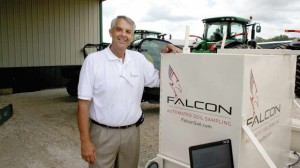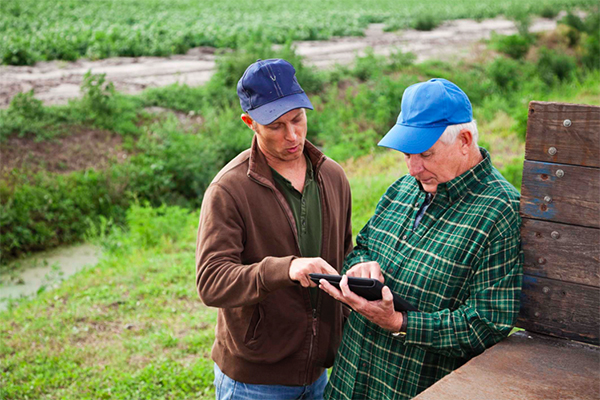Precision Agriculture: Finding The Payback
Since 1995, the International Plant Nutrition Institute has hosted the InfoAg Conference, a gathering of manufacturers, retailers, researchers, advisers and consultants, producers and policy makers within the precision ag industry. Ongoing partnerships formed in 1997 with PAQ Interactive and PrecisionAg in 2005 have helped the conference become the premier event to discuss and view applied precision ag technology. With over 1,400 attendees, the 2014 conference was the largest ever.
Considering the current state of declining crop prices, several presentations and discussions at the conference were focused on the return on investment (ROI) of precision agriculture practices. “Yield matters, even when prices are low” is a quote from one of the presenters at the conference and suggests that spreading input costs over more production units (e.g. higher yields) lowers unit costs of production, thus, increasing maximum net returns. Precision agriculture allows growers to accomplish this goal in a variety of ways.
Dale Bartholomew of GROWMARK said: “ROI [for precision agriculture] comes by doing what needs to be done when it needs to be done.” One could also add, “where it needs to be done,” as GPS guidance is often cited as a profitable precision ag investment. RTK auto-guidance on planters, tillage equipment, sprayers, and combines has been shown to result in an average savings of 5% (ranging from 2 to 7%) on input costs. Auto-swath technology is another popular and profitable technology among dealers and growers. A study conducted by Dr. John Fulton at Auburn University indicated that, on average, a 4.3% savings on input costs could be observed for a farm with a payback of around two years. If the savings due to GPS guidance were included, the total cost savings could be in the 20% to 30% range.

Allan Baucom
In The Zone
Variable-rate technology (VRT) for fertilizer, seed and irrigation was another popular topic at this year’s InfoAg conference. Allan Baucom of A.L. Baucom Family Farms in North Carolina, spoke on several ways VRT is being utilized profitably in his operation. Baucom has been using variable-rate applications for nitrogen (N), potassium (K), gypsum and lime since 1997. One of the keys to their success has been well-defined management zones based on 17 years of consistent soil sampling, harvest data and other agronomic research. They make their applications using auto-guidance, boom height and swath control. They also supplement the map-based prescriptions with on-the-go, in-season NDVI measurements for fine-tuning N recommendations using a GreenSeeker crop sensor. In 2014, using precision ag technology to manage N application in cotton saved Baucom Farms $12.50 per acre, which is well on the way to realizing the internal objective of a $20 per acre total return on technology investment for the operation.
Well-developed management zones can guide not only variable-rate applications, but an entire 4R Nutrient Stewardship program as well. The 4R approach is holistic — considering source, rate, timing and placement of nutrients simultaneously within a specific cropping system context. The right combination of these factors is driven by many site-specific factors; thus, management zones for 4R stewardship should include information on as many of these factors as possible. Tyler Lund of Veris Technologies echoed this thought saying: “A field’s productivity is driven by many factors. So it makes sense that management zones would take these factors into consideration as well.” Tyler’s presentation at InfoAg 2014 focused on fusing a field’s major physical biological and chemical properties into application-specific management zones to guide everything from seeding rates to fertilizer to scouting. He demonstrated how fusing CEC, soil EC, slope and surface oxygen could create “N loss risk” management zones that could be used to minimize N denitrification and leaching losses by guiding source, rate, timing and placement decisions within a 4R program, optimizing profitability of N fertilizer application, while minimizing environmental risk associated with misapplication.
The profitability of precision management was also evident in presentations on multi-hybrid corn planting and variable-rate seeding. Again, the key to success was management zones. Jason Webster of Beck’s Hybrids said in his presentation: “Without management zones, multi-hybrid planters are worthless.” By clearly delineating high and low-yielding zones in the field and changing hybrids between “offensive” in the high-potential zones and “defensive” on the low-yielding areas, Webster was able to raise corn grain yield by 9.5 bushels per acre and increase net profits by over $50 per acre. The same sentiment regarding profitability of management zones for precision agriculture was expressed by John McGuire of Simplified Technology Services who urged advisers and growers to avoid having a “variable-rate because you can” mentality. Discussing variable-rate corn seeding, McGuire pointed out that observing repeatable patterns in field maps “is when you know you are ready to begin making money.” His data demonstrated that varying seeding rate from 28,000 to 38,000 seeds per acre compared to a flat rate of 33,000 seeds per acre resulted in net profits of $6.53 per acre in their 2013 studies.
Agronomically Sound System
So where’s the payback for precision agriculture? One, it’s not found in a single technology, but in a system. Numerous presenters at InfoAg 2014 expressed the importance of a commitment to a precision agriculture system that includes data collection, data analysis, decision-making, technology implementation and record keeping. Also required is the understanding that investing in precision agriculture has a learning curve and patience will be rewarded. Most importantly, however, is the fact that a profitable precision agriculture program must be based on sound agronomic science. Without an agronomic foundation for everything from the information that goes into constructing management zones to the prescriptions for varying inputs, precision agriculture will just be gadgets with no payback and useless data that don’t result in knowledge leading to more efficient input management, higher yields and greater profits.
The next InfoAg will be held July 28-30, 2015 at the Union Station Hilton in downtown St. Louis, MO. Stay informed by visiting www.infoag.org and following @InfoAg.





